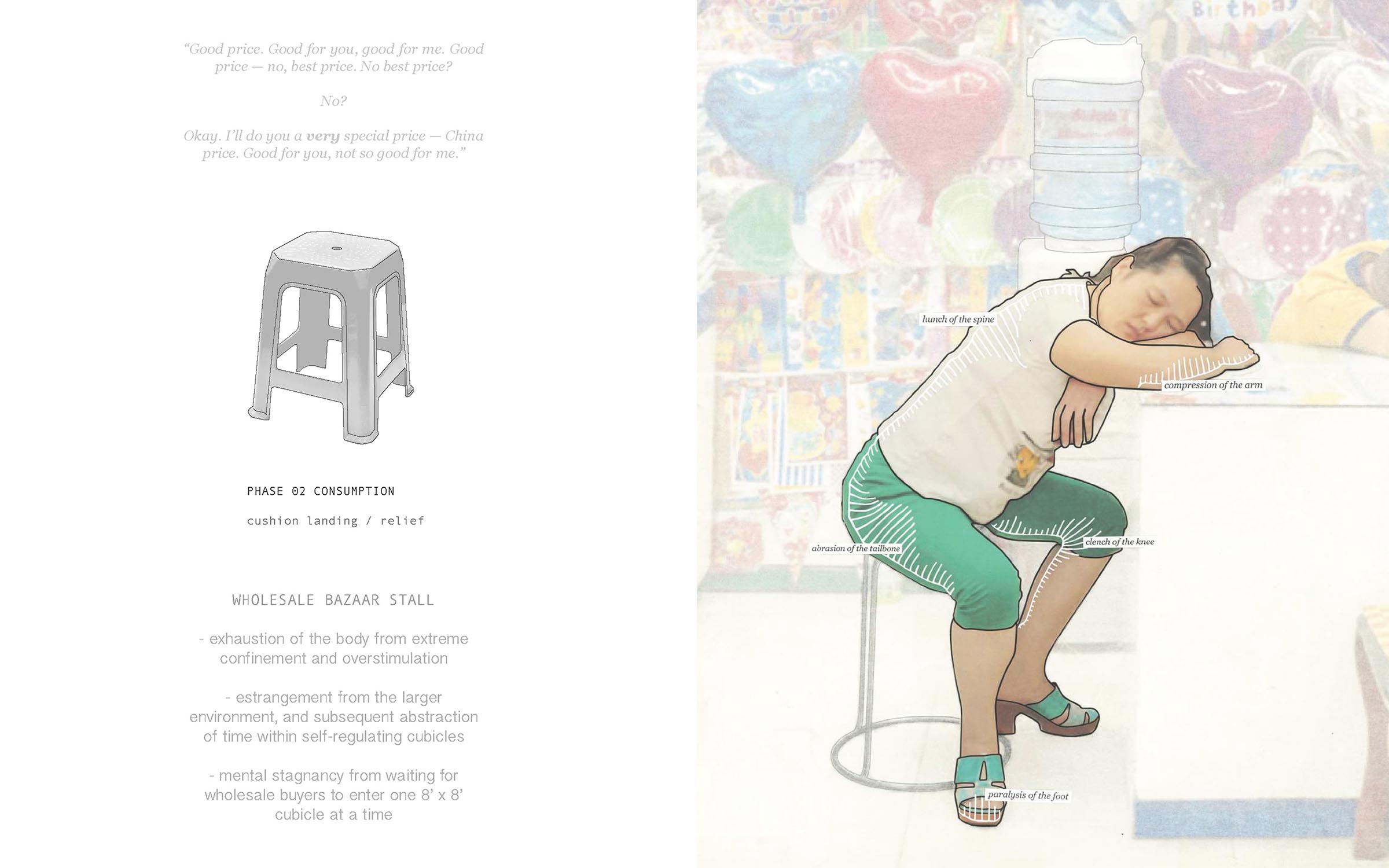Winter 2017 / University of Michigan
First Place, Raoul Wallenberg Studio Award
Published / Dimensions 31
Bachelor Thesis, advised by Dawn Gilpin
First Place, Raoul Wallenberg Studio Award
Published / Dimensions 31
Bachelor Thesis, advised by Dawn Gilpin

mass inurement: commodity king

Taxonomy of artifacts across two sites in Yiwu. Each site is devised to maximize efficiency, whether through time or space.
A semester of research, speculative design, and defining then re-defining towards clarity. This project merges critical thinking with ways of architectural making and drawing, synthesizing both towards a site of humanitarian crisis: Yiwu, China.


Above:
Mapping the flow of goods westward on the new silk road — or a high-speed
34-carriage train chugging 7,456 miles west with millions of dollars
worth of socks, purses, and suitcases, all manufactured and exported from Yiwu.
thesis, draft 8
Globalization redefined our relationship between body and work, superseding holistic making with streamlined assembly. Through mass production, it generated boundless material options, but also the boundless expanse of a global market.
Yiwu — a coastal Chinese city — rose to renown by harnessing new international consumer demand and constructing the world's largest small commodities market. Everyday, Yiwu ships billions of socks, Christmas ornaments, and other "small commodities" — cheap in isolation but lucrative in bulk — to wholesale buyers worldwide.
To maintain this scale of trade, Yiwu's production speed is hyper-efficient and ruthless. Work is principle in Yiwu, and work goes on — even at the expense of the body. Decay is thus embedded into these cyclical work rotations, resurfacing until its presence is mundane, to be expected. The cycle of inurement in Yiwu thus ties indelibly to its history of frenetic production.
Globalization redefined our relationship between body and work, superseding holistic making with streamlined assembly. Through mass production, it generated boundless material options, but also the boundless expanse of a global market.
Yiwu — a coastal Chinese city — rose to renown by harnessing new international consumer demand and constructing the world's largest small commodities market. Everyday, Yiwu ships billions of socks, Christmas ornaments, and other "small commodities" — cheap in isolation but lucrative in bulk — to wholesale buyers worldwide.
To maintain this scale of trade, Yiwu's production speed is hyper-efficient and ruthless. Work is principle in Yiwu, and work goes on — even at the expense of the body. Decay is thus embedded into these cyclical work rotations, resurfacing until its presence is mundane, to be expected. The cycle of inurement in Yiwu thus ties indelibly to its history of frenetic production.

Architecture can disrupt such a cycle of inurement, exposing the dynamic between relief and repression, the single part versus the collective whole. Yiwu's binary relationships offer a glimpse into its incessant production, where rest is an improvised pause from the scripted repetition of work, and the monochrome is a visual break from the slew of polychrome commodities.
This project is thus one of relationships across scales, which we begin to understand only through the rigorous pursuit of clarity. The proposed objects of "care" — operating within this realm — suggest new product forms that question the commodities, processes, and gluttonous consumption the city of Yiwu has surrendered to.
Left: Archetypal Yiwu Christmas factory. There are 600 such factories in Yiwu, which produce 60% of the world’s Christmas decorations.
Right: Archetypal Yiwu Commodity Market. On average, each market houses 65,000 bazaar stalls containing 1.7 million types of small commodities (inflatable toys, clocks, artificial flowers, etc.).




Above: Elevational study of the immaculate, polychrome density of a small commodity market.

Above: Mapping the movement of two Christmas factory workers across one fourteen-hour work day,
where time is narrated by the gradual accumulation of 5,000+ powdered polysterene snowflakes or the daily quota of work.

Above: Mapping the movement of three flower vendors across one nine-hour work day, punctuated by prolonged stretches of stagnancy.



Above: Imagined assembly line for the Powder Guard, overlaid with transcriptions of the cyclical sequence of mass assembly — where the body remains stationary but the hands are deft from rehearsed efficiency.
02. Wake-up Bag ® / small commodity market


Final Exhibition / Juried Symposium

© Karen Duan, 2020